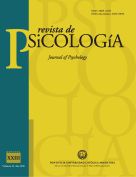Por favor, use este identificador para citar o enlazar este ítem:
https://repositorio.uca.edu.ar/handle/123456789/6140| Título: | Adaptación argentina del PIL Test (Test de Sentido en la Vida) de Crumbaugh y Maholick Argentina adaptation of the PIL Test (Purpose in Life Test) of Crumbaugh y Maholick |
Autor: | Gottfried, Andrés | Palabras clave: | PSICOMETRIA; PSICOLOGIA; SENTIDO DE VIDA; Crumbaugh, James C.; Maholick, Leonard T. | Fecha de publicación: | 2016 | Editorial: | EDUCA Universidad Católica Argentina. Facultad de Psicología y Psicopedagogía. Departamento de Psicología |
Cita: | Gottfried, A. E. (2016). Adaptación argentina del PIL Test (Test de Sentido en la Vida) de Crumbaugh y Maholick [en línea], Revista de Psicología, 12(23). Disponible en: https://repositorio.uca.edu.ar/handle/123456789/6140 | Resumen: | Resumen: El siguiente trabajo profundiza la estructura psicométrica de la adaptación Argentina del PIL Test (Purpose in life Test de Crumbaugh & Maholick, 1969). El instrumento fue aplicado a una muestra de 1.441 personas en edades comprendidas entre 15 y 79 años, de ambos sexos que residían en cinco ciudades de Argentina. Se calculó para la discriminación de los ítems las medias y las varianzas para los sujetos comprendidos en el cuartil superior e inferior respectivamente. Y se procedió a aplicar el test de significación t de Student para muestras independientes. El análisis factorial exploratorio se realizó a los 20 ítems mediante el método de ejes principales y rotación Oblimin. Para calcular la consistencia interna se aplicó el alfa de Cronbach evaluando el peso de cada ítem en la consistencia de todo el instrumento. El estudio de la confiabilidad de los 20 reactivos del PIL alcanzó un coeficiente de 0.89. La varianza total explicada y el gráfico de sedimentación indicaron la existencia de 3 factores que explican el 40.92% de la variabilidad de la varianza total. Finalmente pudo observarse que el PIL Test (versión 2014) adaptación Argentina es un instrumento que presentó satisfactorios índices psicométricos. Abstract: The following paper examines the psychometric framework of Crumbaugh and Maholick Purpose in Life Test (PIL Test). The test was administered to a sample of 1441 subjects between 18 and 79 years of age, of both sexes, living in five cities of Argentina. To calculate the discriminations of the items means and variances of the subjects within the upper and the lower quartile respectively, we applied the significance Student t test for independent samples. Exploratory factor analysis was performed on the 20 items using the axes components method and Oblimin rotation. The total variance indicated the existence of four components that explained 40.92% of the variability within the total variance. The three factors summarized all variables consistently. To calculate the internal consistency of the PIL we applied the reliability of the 20 items of the PIL, which reached the alpha coefficient .89. Finally notes that PIL Test (version 2014) is an instrument with satisfactory psychometric indices. |
URI: | https://repositorio.uca.edu.ar/handle/123456789/6140 | ISSN: | 1669-2438 | Disciplina: | PSICOLOGIA | Derechos: | Acceso Abierto | Fuente: | Revista de Psicología, 12(23), 2016 |
| Aparece en las colecciones: | RdP - 2016 Vol. 12 nro. 23 |
Ficheros en este ítem:
| Fichero | Descripción | Tamaño | Formato | |
|---|---|---|---|---|
| adaptacion-argentina-pil-test.pdf | 632,91 kB | Adobe PDF |  Visualizar/Abrir |
Visualizaciones de página(s)
5.108
comprobado en 30-abr-2024
Descarga(s)
6.631
comprobado en 30-abr-2024
Google ScholarTM
Ver en Google Scholar
Este ítem está sujeto a una Licencia Creative Commons

